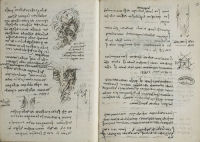The Body of Earth Click on the thumbnails to explore the trail
Read more about this trail (expand)
In his vision of the world, Leonardo saw the planet earth as a living entity, with all of its elements in a constant state of flux. As in nature form follows function, the landscape and all of its elements is seen as a product of the effects of nature that illustrates the bodily mechanisms of the earth.

- Enlarge
- Zoom & explore
- Fol 18v-19r - The nature of water. Photo RMN - © René-Gabriel Ojéda
Paris Manuscript F 1508-13
The most visible and dynamic of all the elements, water provided a means of understanding the forces that drove all the elements into action. Leonardo studied water relentlessly. He compared the flow of water to the flow of air and, quite accurately, water waves to sound and light.
Leonardo was particularly interested in vortices and the erosive power of water, both which he considers on Fol 18v. In the upper drawing, flowing water encounters an obstacle in its path. He observes how the heavier water lying at the bottom of the stream encounters the obstacle first and rises up, crashing into the lighter water on top and forcing it outwards to form vortices.
In the lower drawing, water gushes forth through the gates of a lock and Leonardo notes how it erodes the bottom more on one side than the other.
The vortices in Leonardo’s drawing are not unlike the spiralling curls of hair or the leaves of plants that often appear in his paintings and drawings. This illustrates his belief in the interconnectedness of all natural forms and the all-governing creative power of nature.
In Leonardo's words
Moving water strives to maintain the course pursuant to the power which occasions it, and if it finds an obstacle in its path it completes the span of the course it has commenced by circular and revolving motion.
The main subjects of Manuscript F are water, the science of optics, geology and astronomy.
Leonardo also poses interesting cosmological questions in this manuscript, as he speculates on the nature of light on the moon, the origins of its spots, and the appearance of the earth as it would be seen by someone standing on the moon.
The compactness of the writing and homogeneity of writing style in this manuscript indicates that it was compiled during a relatively short time span.
The manuscript comprises of 96 folios.
- Medium Pen and ink on paper
- Size 14.5 x 10 cm
- Location Bibliothèque de l’Institut de France










